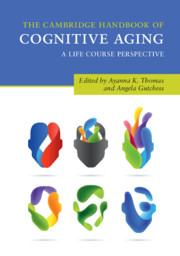Book contents
- The Cambridge Handbook of Cognitive Aging
- The Cambridge Handbook of Cognitive Aging
- Copyright page
- Contents
- Figures
- Tables
- Contributors
- Introduction
- Part I Models of Cognitive Aging
- Part II Mechanisms of Cognitive Aging
- Part III Aging in a Socioemotional Context
- Part IV Cognitive, Social, and Biological Factors across the Lifespan
- 23 Prenatal Influences on Cognitive Aging
- 24 Associations between Activity Participation across the Life Course and Cognitive Aging
- 25 Cognitive Aging and Culture: Older Brain Predictions about Different Environments
- 26 Current Perspectives on Aging and Bilingualism across the Life Span
- 27 Grit and Successful Aging
- 28 Control and Cognition: Contextual and Individual Differences in Cognitive Aging
- 29 Cognition and Well-Being across Adulthood and Old Age
- 30 The Genetics of Cognitive Abilities
- 31 Blood Biomarkers of Cognitive Health and Neurodegenerative Disease
- Part IV Summary: Early Life and Biological Factors
- Part V Later Life and Interventions
- Index
- Plate Section (PDF Only)
- References
25 - Cognitive Aging and Culture: Older Brain Predictions about Different Environments
from Part IV - Cognitive, Social, and Biological Factors across the Lifespan
Published online by Cambridge University Press: 28 May 2020
- The Cambridge Handbook of Cognitive Aging
- The Cambridge Handbook of Cognitive Aging
- Copyright page
- Contents
- Figures
- Tables
- Contributors
- Introduction
- Part I Models of Cognitive Aging
- Part II Mechanisms of Cognitive Aging
- Part III Aging in a Socioemotional Context
- Part IV Cognitive, Social, and Biological Factors across the Lifespan
- 23 Prenatal Influences on Cognitive Aging
- 24 Associations between Activity Participation across the Life Course and Cognitive Aging
- 25 Cognitive Aging and Culture: Older Brain Predictions about Different Environments
- 26 Current Perspectives on Aging and Bilingualism across the Life Span
- 27 Grit and Successful Aging
- 28 Control and Cognition: Contextual and Individual Differences in Cognitive Aging
- 29 Cognition and Well-Being across Adulthood and Old Age
- 30 The Genetics of Cognitive Abilities
- 31 Blood Biomarkers of Cognitive Health and Neurodegenerative Disease
- Part IV Summary: Early Life and Biological Factors
- Part V Later Life and Interventions
- Index
- Plate Section (PDF Only)
- References
Summary
With world population senescence and globalization, more present-day older adults will evince cognitive aging that is influenced over a longer life span by a wide range of social practices and motivational beliefs from cultural groups across the world. Although there is no dispute that brain structure and function aggregate biological and experiential influences, a useful framework is still needed regarding the specific neural mechanisms underlying the exchange between biology and experience with age, and the effect on cognition. We introduce a predictive coding framework of the aging cognitive brain that views the older brain as making predictions about the environment based on a lifetime of experience in it. The influence of cultural experiences in shaping the aging predictive brain then reflects individual differences in processing social signals about appropriate or inappropriate behaviors and cognitive styles amid neural resources changes. We briefly annotate relevant findings on age effects and cultural differences in neurocognitive processing. We further review findings showing that cultural cognitive differences are present in children, persist in young adulthood, and are either maintained or accentuated in older adulthood. Finally, we consider that the predictive aging brain is an enculturated one, reflecting the accumulation of a lifetime of experiences that have fortified culture-specific modes of thought and neural processing in older adults.
Keywords
- Type
- Chapter
- Information
- The Cambridge Handbook of Cognitive AgingA Life Course Perspective, pp. 457 - 479Publisher: Cambridge University PressPrint publication year: 2020
References
- 1
- Cited by

